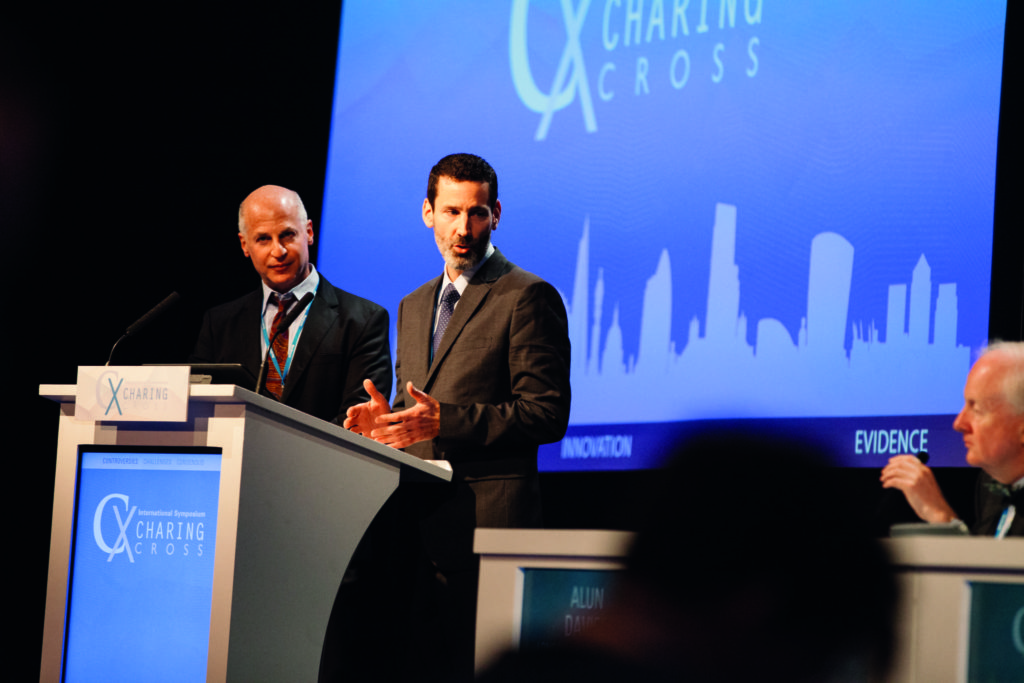 According to a debate at the Charing Cross Symposium (CX; 24–27 April, London, UK), the vast majority of CX delegates disagree with the view that the ATTRACT trial has provided the definitive answer on the use of pharmacomechanical catheter-directed thrombolysis for deep vein thrombosis—more than 80% voted against the motion “ATTRACT is the final word on lysis of proximal deep vein thrombosis”.
According to a debate at the Charing Cross Symposium (CX; 24–27 April, London, UK), the vast majority of CX delegates disagree with the view that the ATTRACT trial has provided the definitive answer on the use of pharmacomechanical catheter-directed thrombolysis for deep vein thrombosis—more than 80% voted against the motion “ATTRACT is the final word on lysis of proximal deep vein thrombosis”.
The ATTRACT trial, which was presented at CX 2017, found that the addition of pharmacomechanical catheter-directed thrombolysis to anticoagulation did not reduce the risk of post-thrombotic syndrome in patients with proximal deep vein thrombosis. However, it did find that—compared with anticoagulation alone—the combination did result in a higher risk of bleeding.
The aim of the CX Debate was to discuss whether or not the trial meant the end for exploring the use of pharmacomechanical catheter-directed thrombolysis in this subgroup. Speaking against the motion that ATTRACT has final say, Mitchell Silver (Columbus, USA) said that there were several “facts” about the ATTRACT trial that undermined its findings. These included that the results did not apply to the patients “we treat every day”, with Silver claiming “only one in 50 patients screened were randomised” and that “these results are not generalisable”; that the primary endpoint was “flawed” because the Villalta score (used to assess post-thrombotic syndrome) was applied in a binary fashion, which was a too stringent approach to use for the primary endpoint; and that “ATTRACT was too underpowered to look at the group that has the highest risk of post-thrombotic syndrome and benefits the most from intervention”. Regarding the higher bleeding rate seen in ATTRACT, he noted that the median duration of tissue plasminogen activator (tPA) treatment was “21 hours” and that a shorter treatment time would result in less bleeding.
Brian DeRubertis (Los Angeles, USA), who was speaking for the motion, said for the sake of debate he would argue that ATTRACT was the final word on lysis due to the rigorous and well-designed nature of the trial, but acknowledged that the study had its limitations. However, he said that the problems with ATTRACT were “common to all randomised trials”. as issues of patient accrual oftentimes require compromise in inclusion criteria and because of the fact that lessons are learned during the conduct of the trial. “Randomised controlled trials strike a balance between broad applicability to different patient populations, obtaining answers to specific questions of interest and timely completion of the trial,” DeRubertis commented. He added: “Our goal with well-designed clinical trials should be to look deeper into the trial results, beyond the abstract or publication headlines, and see if there are valid lessons to be learned.” Summing up his view on the study, he stated: “I think we can learn a lot from ATTRACT and any similar trial going forward. Among the specific lessons we have learned from ATTRACT is that while not all patients would be expected to benefit from lysis, there is a subset of younger patients with proximal iliofemoral disease that can be expected to derive significant benefit.”
After DeRubertis and Silver had both stated their arguments, the discussion moved onto what further trials were needed and, in particular, the endpoints that should be used. According to Silver, a “modern era” deep vein thrombosis trial was in the planning stages. He explained, unlike the ATTRACT trial, this would use current approaches—such as intravascular ultrasound (IVUS), shortened tPA procedure time, and “mandated post procedural imaging”. “The question will be answered,” he claimed.
However, speaking from the audience, Mark Meissner (Seattle, USA) declared it to be “absolute nonsense” to continue funding research in this area “until you spend five years finding another outcome measure”. He added you cannot do it as part of a randomised trial, commenting “we are throwing very good money away if we keep asking the wrong question. Although very well done, we get a right answer but not one that is useful. It is not helpful to ask if pharmacomechanical catheter-directed thrombolysis is a first-line therapy for all comers—we all know that it is not—and then look at an absolutely nonsensical clinical outcome measure to support it. So, I do not think we should throw another dime at this.”












